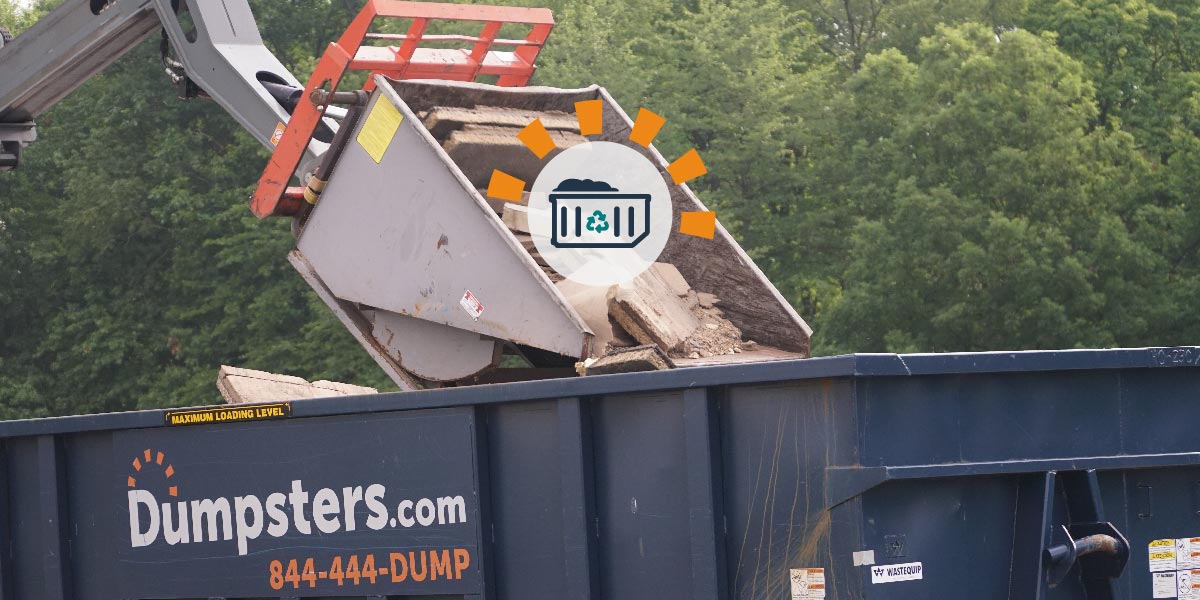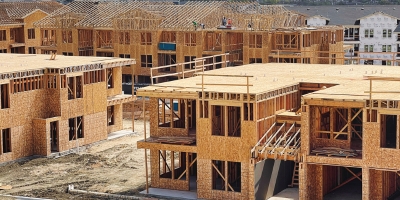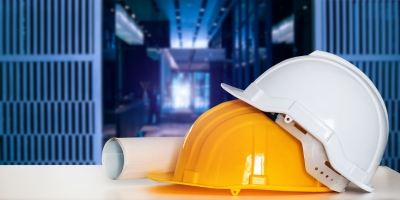On-Site vs. Off-Site Sorting: Which Construction Waste Recycling Method Is Best?
Here are seven factors to consider when deciding how to sort your waste.

Should You Sort Waste in Separate or Commingled Cans?
Sustainability is an ever-increasing focus in the construction and demolition industry. As a result, recycling has become top of mind since it saves on energy, materials and workforce costs.
Implementing a recycling strategy is critical in getting the best results for your jobsite. You can use two different sorting options for recycling: on-site and off-site. But is one better for you? Let’s dig into the answer.
What’s the Difference Between On-site and Off-site Recycling?
With off-site recycling, you place different materials (wood, cardboard, metals, etc.) into the same dumpster. A hauler picks up the bins and sends them to a transfer station, where workers separate the debris into reusable materials to recycle and landfill waste. Off-site recycling is also known as commingled or single-stream recycling.
On-site recycling – also referred to as source-separated recycling – involves several dumpsters. Each material goes into a different container to lower the chances of cross-contamination. Haulers then take these dumpsters to facilities that accept the appropriate materials, and what they can’t reuse is sent to a landfill in separate bins.
7 Factors to Consider When Choosing Between On-site and Off-site Sorting
Before choosing a sorting method, identify your overall recycling goals. Do you have a recycling and waste estimate in your waste management plan? Are you trying to recoup expenses, obey regulations or meet contract requirements?
Once you know your goals, there are seven common factors to consider when deciding whether to sort on-site or off-site.

1. Cost
The off-site sorting approach uses fewer dumpster rentals and hauler deliveries, creating lower costs. Off-site is the no-frills option that won’t add significant expenses to your balance sheet.
However, you’ll get a higher recycling rebate with on-site sorting because separate cans prevent materials from being contaminated. By using different bins, more material will be accepted for recycling than using a mixed dumpster, which could lose some material to contamination.
But even with these rebates, you’ll still need to rent more dumpsters and pay for more dumpster deliveries by sorting on-site. The average cost of a dumpster rental nationwide is often over $400. So, multiply $400 by how many materials you want to separate and recycle – plus the delivery fees – and you can see how on-site expenses add up quickly when compared to off-site recycling.
Takeaway: On-site sorting will get you a better recycling rebate, but off-site sorting will give you a lower total cost by using fewer dumpsters.

2. Space
If you want to use on-site separating, you need to know where the dumpsters for each material will go. Is there enough room on your jobsite for each container? Can traffic work around the bins efficiently, or will they slow things down?
Here’s what the executive director of the Construction & Demolition Recycling Association had to say.

“Space is always a challenge, but especially crowded downtown. Trying to squeeze four or five dumpsters in a small lot might not be possible.”
Off-site sorting requires fewer bins, taking up less space than on-site sorting.
Takeaway: If space is limited and maintaining efficiency is vital for the project, it’s best to use a commingled bin.

3. Time
Setting up separate material cans on-site and informing employees how to use them correctly takes time. If they misplace material and a dumpster gets contaminated, the bin could be rejected by the recycling facility and could force the hauler to find somewhere else to deposit the waste.
That delay will have a domino effect: The hauler can’t bring the dumpster for use until it’s emptied, and your workers can’t throw new waste away without one. Depending on how many dumpsters you’re using, this could be a minor inconvenience or completely stop all work.
Also, the more dumpsters you use, the more traffic you’ll have on your worksite – extra traffic that can create delays or bottlenecks.
Off-site sorting, on the other hand, saves you time since you’ll only need one dumpster, you won’t have to give detailed instructions to your team, and you won’t have as much traffic on your jobsite. Instead, a commingled can will be picked up and swapped out, and the recycling facility will do the rest.
Takeaway: If saving time is essential for the project deadline, you’ll want to sort your waste off-site since it requires less labor for setup, planning and maintenance – and, therefore, less time.

4. Workflow and Process
Knowing which sorting strategy will help or hinder your work is essential. Since off-site recycling requires fewer bins on the jobsite, fewer trucks will come and go, keeping the workflow smooth. Plus, it’s easier for you and your team.
Meanwhile, with on-site recycling, you need to set aside time to clearly communicate to your team about which materials go where. Besides, you’ll have to incorporate deliveries that could interrupt your workflows. More traffic on-site may slow down or block trucks dropping off building materials and keep your workers from getting where they need to be.
Takeaway: Off-site sorting is less likely to hinder your process and will provide a smoother workflow than on-site sorting.

5. Waste Diversion
On-site sorting has a clear advantage with waste diversion. By separating materials into their own bins, you have more control over what gets recycled. Individual material bins create a lower risk of contamination, so more material will be recycled, resulting in a higher diversion rate.
The risk of recyclable materials going unnoticed or getting contaminated in a commingled bin means it’s harder to reach high waste diversion rates with single-stream recycling.
Which option is better depends on your ultimate goals for the project. Do you need a large percentage of your waste recycled? Is it important to get points in LEED scoring? Or do you require the job done fast at a low cost?
Takeaway: The right choice depends on what you want to accomplish with your waste diversion goals.

Pro-Tip
The best way to determine if you need to do on-site recycling to achieve your objectives is to create a waste management plan. We provide a free template on how to make one.

6. Environmental Impact
On the surface, on-site recycling appears to be the obvious choice for having less of an impact on the environment. A dumpster sorted on-site will create less waste in a landfill than off-site. But there are other variables to consider.
First, look at vehicle emissions. When you use more dumpsters, more trucks make trips to the site and recycling facilities. You may recycle more, but you’ll create a higher carbon footprint.
Second, if a recycling facility is adept at separating materials, sorting off-site may not have that much of a worse environmental impact than sorting on-site since the dumpsters frequently end up at the same place. As Turley, CDRA’s executive director, explains, “Often, materials separated on-site will get sent to the same facility as commingled boxes because it’s the only facility that can recycle the materials.”
The good news? “Mixed C&D processing facilities can do a really good job separating recyclable materials,” he added.
Takeaway: On-site sorting may seem the best for the environment, but off-site sorting can generate similar recycling rates to on-site if they’re all recycled at the same place.

7. Availability
In the end, the sorting approach depends on what disposal options are available in your area and the capabilities of local sorting facilities. You may not be able to recycle some materials at facilities within driving distance. A diversion rate may not look all that different between an on-site or off-site method if the facilities are limited in what they can accept. It boils down to capabilities in the region and how well your waste management service can optimize them.
The Bottom Line: Off-site Is the Best Option Except in Specific Circumstances
Unless the scale of the job is large, uses many resources and has adequate facilities for recycling close by, off-site sorting is usually the better choice for recycling. It will save time, money and space on a jobsite.
Consider a Combination of Both Approaches When Meeting High Waste Diversion Rates
What happens if you need to achieve a high diversion rate for a job, but would prefer to use an off-site recycling method to reduce costs, keep your project moving and prevent too many containers from cluttering up your worksite?
In cases like this, you could do both through an approach called hybrid recycling. Let’s say you’re building a big box store in a rural area. The customer wants reports on recycled concrete. The area has one facility that will recycle concrete but not much else, and another that takes everything but concrete. You could use a 30 yard dumpster for commingled waste and a 20 yard dumpster solely for concrete and recycle both dumpsters using the two facilities.
Whether it’ll be beneficial to use a hybrid model depends on your recycling rate goals, what materials you’re tossing and what the local facilities can do for you.
Find a Nationwide Partner Who Can Help Find the Right Sorting Method
One variable you can’t control is what the area can recycle. But you can control who manages your waste and find a partner who can make the most of what recycling is available.
Look for a waste provider that can be flexible and work with you to get the best possible recovery rate. Finding a vendor who can do either option or a combination of both is ideal.
Some waste management service providers only work with one or two recycling facilities in the area, or have a limited inventory. A hauling service with access to more recycling facilities near your project, as well as more dumpster sizes and types, can help you achieve your recycling goal with fewer complications.
We can assist with that.
One of our account executives, Trevor Ditch, explains this further.

“Through our vast network of providers, we can achieve some of the highest recovery rates in different areas for on-site and off-site. You will only need one point of contact, and you’ll get only one bill for that service.”
Rent a Roll Off Dumpster for Your Next Job
Tell us about your project, and we can help you pick the dumpsters that are right for your budget and your waste diversion goals. Call 833-499-7510 or request a quote to get started.
What Do You Think?
Have thoughts on this topic? We're listening. Head over to Twitter or Facebook,
and use #dumpstersblog to join the conversation.



